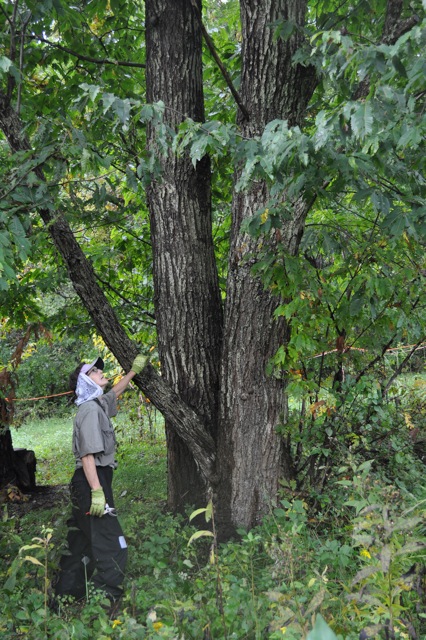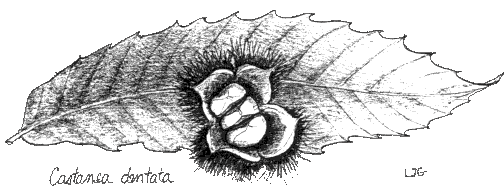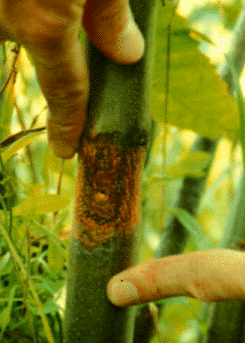American Chestnut Cooperators' Foundation
Blight Fungus
![]()
A lethal strain of the blight fungus was inoculated into this American chestnut stem. The sunken canker is typical for a blight-susceptible American chestnut.
![]()
Chestnut blight is caused by a fungus which entered our country on Asian nursery stock imported to New York around 1900. Spread by wind, rain, birds and other animals, it enters through cracks or wounds in the bark, multiplies rapidly, making sunken cankers which expand and girdle the stem, killing everything above the canker, usually in one growing season. Because it had never before been exposed to this fungus, the American chestnut was highly susceptible; like the native American tribes exposed to smallpox, the American chestnut was devastated throughout the natural range, extending over the Appalachian hills and highlands from Maine to Georgia. By 1940, three and a half billion American chestnuts had perished.
Formerly the tallest trees in our eastern hardwood forests (100 feet tall was common), American chestnuts survive mostly as small understory trees that sprout back from the original root systems and are continuously attacked by the blight. Even where all the American chestnuts have been killed, the blight fungus is still present. When you see American chestnut stock advertised as "blight free", this means it was grown in an area where no blight is present, outside the natural range or inside a greenhouse. This is no guarantee that the tree will not contract blight in the future.
In all the scientific literature before 1978, the blight fungus is identified as Endothia parasitica. In 1978, it was renamed, Cryphonectria parasitica. The new name has gained acceptance for want of time or inclination to argue a point which cannot advance chestnut blight research. Whichever Latin name is cited, it is the same chestnut blight fungus.
Some Facts About Blight Resistance
American chestnut seedlings are usually highly susceptible to the blight. In older trees (more than 1.5 inches in diameter at breast height), a resistant individual can slow down progress of the disease and may survive in spite of blight, but it is not immune. Many kinds of environmental stress may break down a tree's resistance to blight. Indeed, at higher elevations in areas exposed to severe climate, normally resistant, Oriental chestnuts have been killed by blight. When we search for possible sources of blight resistance, we look for American chestnuts greater than 10" DBH (Diameter at Breast Height) which have swollen blight cankers (as illustrated in the February 1990 National Geographic, page 132).
Some Facts About Hypovirulence
Hypovirulence is a virus disease of the blight fungus. Weakened by the virus, the blight's progress is slowed down, so that a chestnut tree which may have no resistance to blight can form the slow-growing swollen cankers normally produced only on resistant trees. Scientists have been trying to manipulate hypovirulence to develop an economical biocontrol for blight. Among the obstacles to be overcome are 1) the blight spreads very rapidly in nature, while hypovirulence spreads very slowly; 2) there are many types of virulent strains in the forest which resist transfer of the virus responsible for hypovirulence; and 3) good, swollen, slow-growing cankers sometimes change into bad, sunken, rapid-growing cankers that kill trees.
Integrated management for American chestnut revival combines hypovirulence (by inoculation) with blight-resistance (grafted) on sites identified as ideal American chestnut habitat, to produce blight control. In Virginia's Lesesne State Forest, 3 resistant American chestnuts were grafted in 1980. In 1982 and 1983 the first cankers were inoculated with hypovirulence.

These trees are thriving; they have produced nuts since 1989 and make excellent annual growth.
They are surrounded by non-resistant American chestnuts which are continuously killed back by the blight. Cooperative research with the Virginia Department of Forestry, Virginia Tech and ACCF.To learn how to find the best sites for American chestnut revival projects go to American Chestnut Habitat
For details of the research, refer to the Bibliography.
To join the American Chestnut Cooperators' Foundation, please return to our home page American Chestnut Cooperators' Foundation

